In recent years, rural areas in Asia have gained attention for their potential. They offer a chance to boost local economies with new business ideas. These areas face challenges but also hold great opportunities for growth.
Entrepreneurs can use sustainable business models to unlock rural potential. This can lead to economic growth, better lives, and stronger communities.
Understanding the Needs of Rural Areas

Rural areas have special needs for economic growth. A detailed rural needs assessment is key. It spots challenges like limited services, poor infrastructure, and unique cultural ways.
Getting the community involved is crucial. By listening to locals, businesses can make better plans. Insights from farmers and entrepreneurs are especially helpful.
Here are key factors to consider:
- Access to healthcare and educational facilities.
- Quality of transportation networks and connectivity.
- Availability of resources for local livelihoods, including water and land.
- Cultural practices and values that influence economic activities.
By engaging deeply and assessing well, businesses can help local areas grow. They can respect each area’s special traits. This approach improves life quality and boosts the economy.
Innovative Business Ideas for Rural Areas in Asia
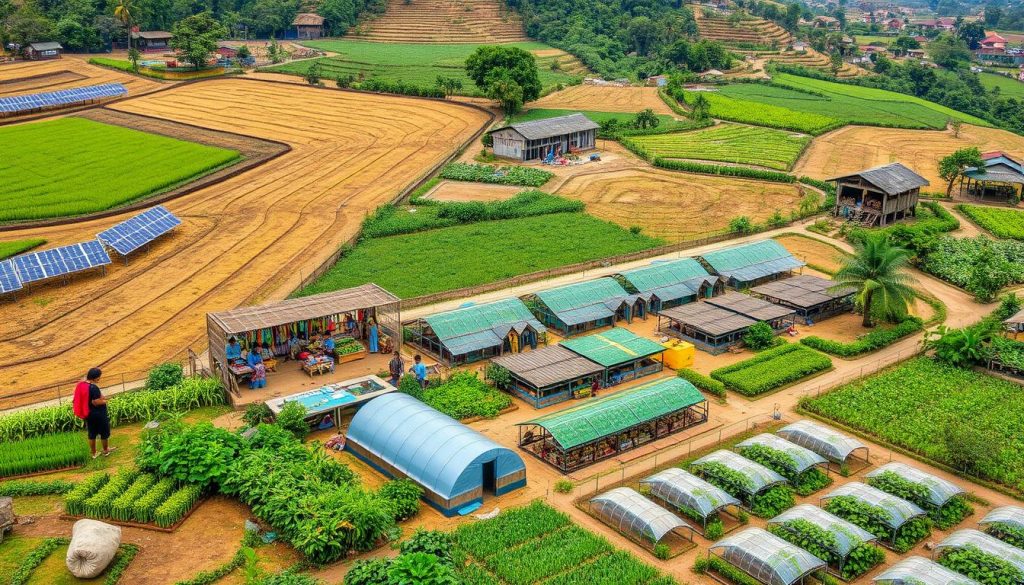
Rural entrepreneurship in Asia is full of opportunities. It uses local resources and meets community needs. New businesses can help grow the economy and make life better for people living there. There are many business ideas for different areas, tackling specific problems.
Some amazing examples include:
- Community-supported agriculture initiatives, which connect local farmers directly with consumers, enhancing food security and income stability.
- Eco-tourism ventures that harness natural beauty and cultural heritage, providing visitors with immersive experiences and generating revenue for local communities.
- Handicraft cooperatives that enable artisans to market their products effectively, promoting traditional crafts while ensuring fair wages.
These innovative ventures not only create jobs but also inspire a new generation of rural entrepreneurs. As these business ideas grow, they lead to sustainable practices. They help solve economic and social problems in rural areas.
Leveraging Technology in Rural Business
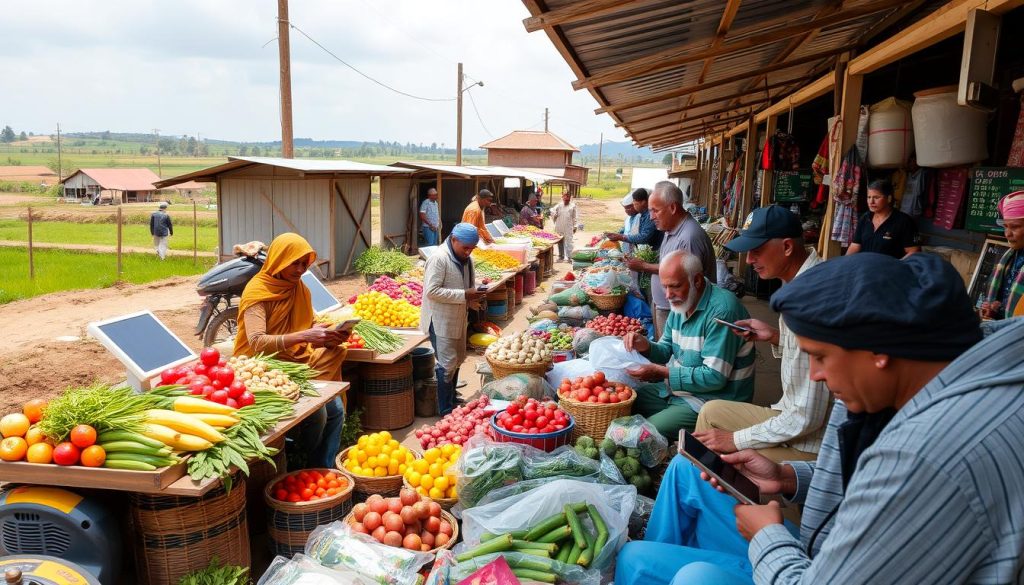
Technology has changed rural businesses for the better. It brings new chances for growth and lasting success. With mobile apps and online marketplaces, rural businesses can innovate in agriculture and reach more customers. This helps communities grow and boosts their economy.
Mobile Applications for Agriculture
Mobile apps are key in updating farming. They give farmers tools like weather forecasts and market prices. This helps farmers work smarter and sell their produce faster.
Apps connect farmers with buyers directly, cutting out the middleman. This makes farming more efficient and productive. It’s a crucial part of using technology in rural businesses.
Online Marketplaces for Local Crafts
Online marketplaces have changed how artisans sell their work. They let local makers show their products worldwide, reaching more people. This way, artisans can earn money and keep their traditional skills alive.
These platforms are easy to use and don’t cost much to start. They help rural craftsmen become financially independent. This shows how important technology is for rural businesses, supporting sustainable growth.
Sustainable Agriculture Ventures
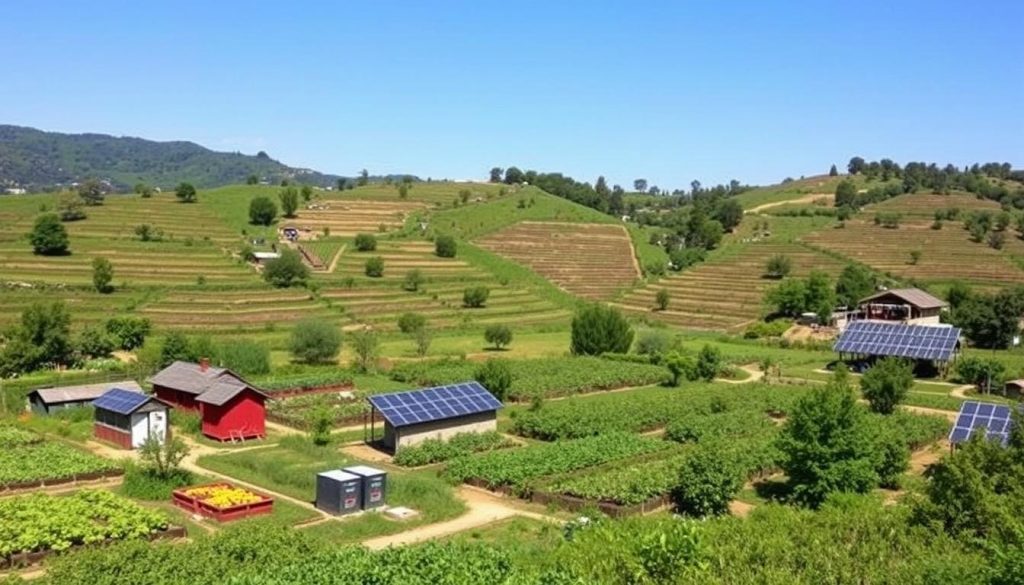
Sustainable agriculture focuses on keeping the environment healthy and boosting farm productivity. Organic farming and agroforestry are key areas. They help the planet and support local communities and economies.
Organic Farming Initiatives
Organic farming uses natural ways to grow crops. This makes the soil better and brings more life to farms. It avoids harmful chemicals, creating a healthier environment.
Local farmers are turning to organic methods. This leads to better food and new market opportunities. It also helps them earn more.
Agroforestry Practices
Agroforestry mixes trees and shrubs with crops. It makes the soil better and keeps water in the ground. This is good for crops.
It also makes farms more resilient to climate change. Studies show it increases farm productivity. Plus, it helps capture carbon and supports wildlife.
Tourism Development Opportunities

Rural areas have a lot of potential for tourism growth, especially in eco-tourism and cultural heritage. These ideas not only draw in visitors but also help protect the environment. They also bring communities together. By using nature and cultural sites, we can make tourism lively and help local economies.
Eco-Tourism Projects
Eco-tourism is about travelling in a way that respects nature. It lets visitors enjoy the outdoors while keeping it safe. Rural areas can benefit from eco-tourism by offering:
- Guided nature walks that show off local wildlife
- Wildlife tours that teach about conservation
- Community-led tours that teach about living green
Cultural Heritage Experiences
Cultural heritage is key to making rural tourism special. It lets visitors experience local traditions, crafts, and history. Good cultural experiences include:
- Workshops where visitors can learn from local artists
- Festivals that celebrate local history and culture
- Tours that tell the stories of the community’s past
Renewable Energy Solutions

Rural areas in Asia can greatly benefit from renewable energy, especially solar energy. Moving to solar energy farms brings many advantages. These include lower energy costs, more sustainability, and more independence for communities.
Rural energy solutions can also boost local economies. They help solve energy access problems.
Solar Energy Farms
Solar energy farms are key to sustainable development in rural areas. They turn sunlight into electricity, powering homes and businesses. This is especially important where reliable energy is scarce.
Setting up solar farms in rural areas offers several benefits:
- Lower electricity bills, helping families financially.
- Less pollution, making the environment healthier.
- New jobs in solar panel setup and care.
- More energy independence, making communities self-sufficient.
Solar energy farms in rural Asia show great promise. Countries like India and the Philippines have seen success. These projects improve lives and boost local economies.
Craft and Artisanal Products
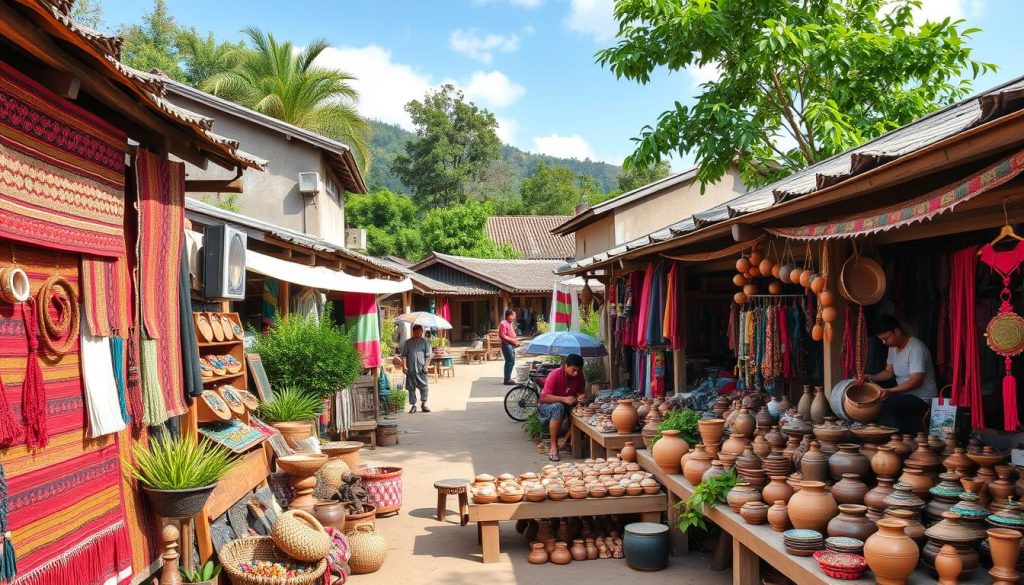
Supporting craft and artisanal products is key for rural areas. It boosts the economy and keeps local traditions alive. Rural crafts carry unique heritage, making products special and connecting artisans to their roots.
By valuing these products, communities can create jobs. They also celebrate and keep their cultural identity alive.
Promoting Local Handicrafts
To promote local handicrafts, several steps can be taken:
- Organising artisan fairs to showcase the skills and creativity of local craftsmen.
- Utilising global market platforms to reach a wider audience and increase sales potential.
- Creating online profiles to highlight the stories behind each artisanal product, enhancing consumer connection.
- Implementing workshops that educate the community about the importance of cultural preservation through crafts.
Education and Skill Development Programs

Starting a business in rural areas needs good education and skills. Programs that make learning easy are key. They help people get the skills needed to succeed locally. Vocational training is also important, teaching skills that meet community needs.
These programs help people find jobs and become self-sufficient. They boost employability and help people stand on their own.
Vocational Training Initiatives
Vocational training focuses on skills needed for local jobs. It covers many areas:
- Agriculture and horticulture skills
- Handicraft and artisanal production techniques
- Basic business management and entrepreneurship
These programs are crucial for more jobs and economic growth in rural areas.
Online Learning Platforms
Online learning has changed education in rural areas. It offers many advantages:
- Flexibility in learning schedules
- Diverse course offerings tailored to various skill levels
- Accessible resources that support self-paced learning
Online education lets rural people learn skills for today’s jobs. It keeps them competitive in a digital world.
Health and Wellness Startups

Health startups are changing how we think about rural health. They create wellness solutions for the special needs of rural areas. For example, telemedicine helps people in remote places get medical help without leaving home.
Telemedicine connects patients with doctors online. This means people in far-off places can get the care they need quickly. It’s a big step forward in making healthcare more accessible.
Mobile health apps are also making a big difference. They help users manage their health by scheduling appointments and tracking their health. These apps can help people live healthier lives, especially in rural areas.
Wellness programs are becoming more important too. They focus on both mental and physical health. Things like community workshops, fitness classes, and mental health support are helping to improve health standards.
Working together, health startups and local groups can do even more. They can make wellness programs more effective and reach more people. This teamwork is key to improving health in rural areas.
Water Management Solutions
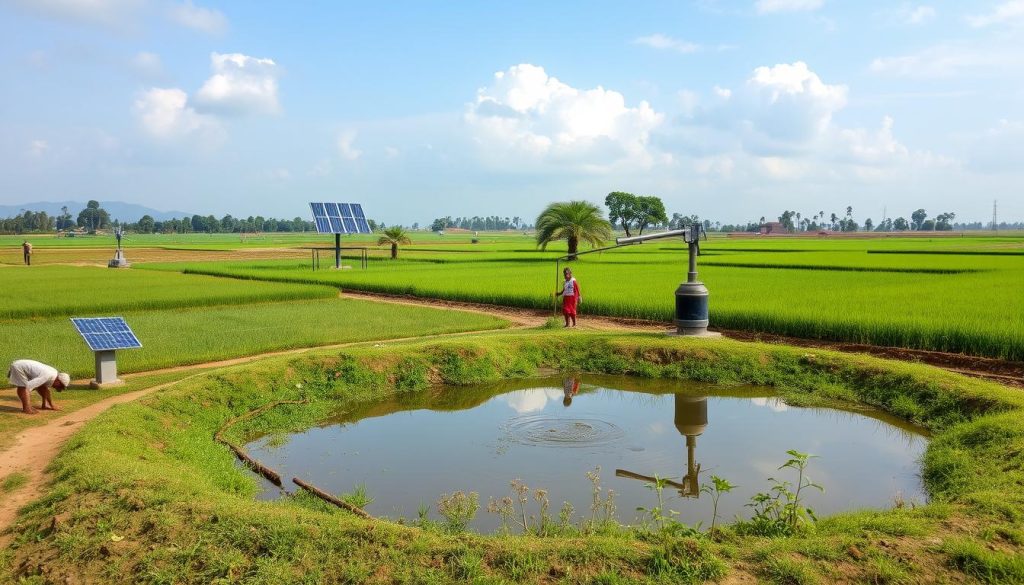
Effective water management is key to boosting farm productivity, especially in rural areas with water shortages. New irrigation methods help in sustainable farming. They lead to better crop yields and save resources.
Irrigation Technologies
Modern irrigation tech helps farmers use water wisely and keep crops watered. Some top methods are:
- Drip Irrigation: It sends water straight to the roots, cutting down on waste.
- Rainwater Harvesting: It collects rainwater for use when it’s dry, reducing the need for other water sources.
- Sprinkler Systems: These spread water over fields like rain, but in a controlled way.
Using these irrigation methods saves water and supports green farming. It makes crops stronger and soil healthier. Good water management helps farmers work well even when it’s tough, keeping their jobs safe and boosting the economy.
Value-Added Food Production
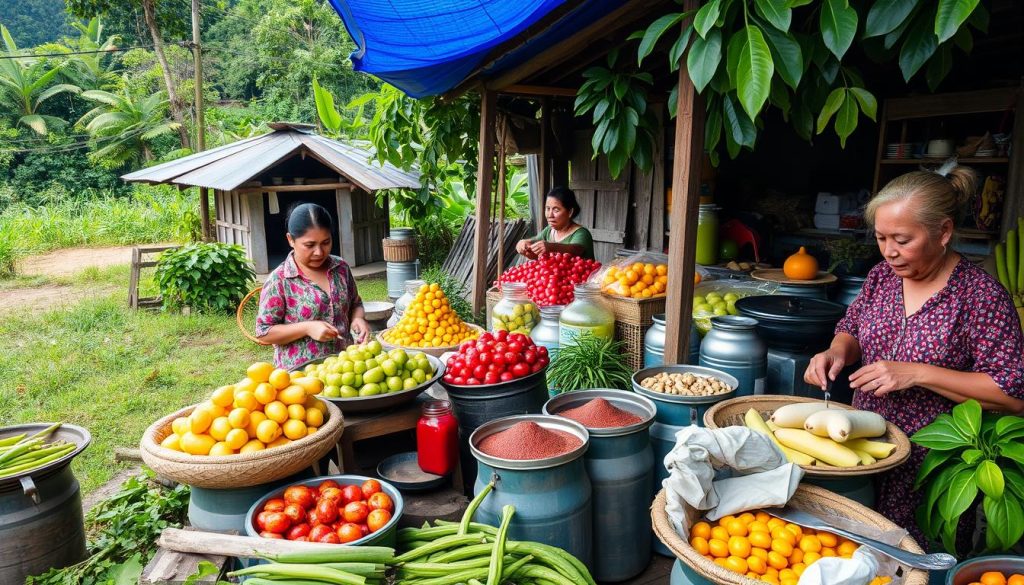
Increasing food production efficiency through value-added products is a big chance for rural areas. Local processing facilities are key in turning raw materials into products people want. This makes farming communities more economically stable.
By setting up these facilities, areas can create jobs. They also help local farmers earn more by improving the value of their products.
Local Food Processing Facilities
Local processing facilities help create a sustainable food system. They bring many benefits, such as:
- Creating jobs in rural areas, boosting local economies.
- Reducing food waste by using extra raw materials for value-added products.
- Helping local farmers earn more from their crops.
- Improving food quality and safety for consumers.
More people want locally sourced and sustainable food. This demand grows for value-added items. It encourages investment in local processing. This not only boosts food production but also supports community resilience and sustainability.
Transportation and Logistics Innovations
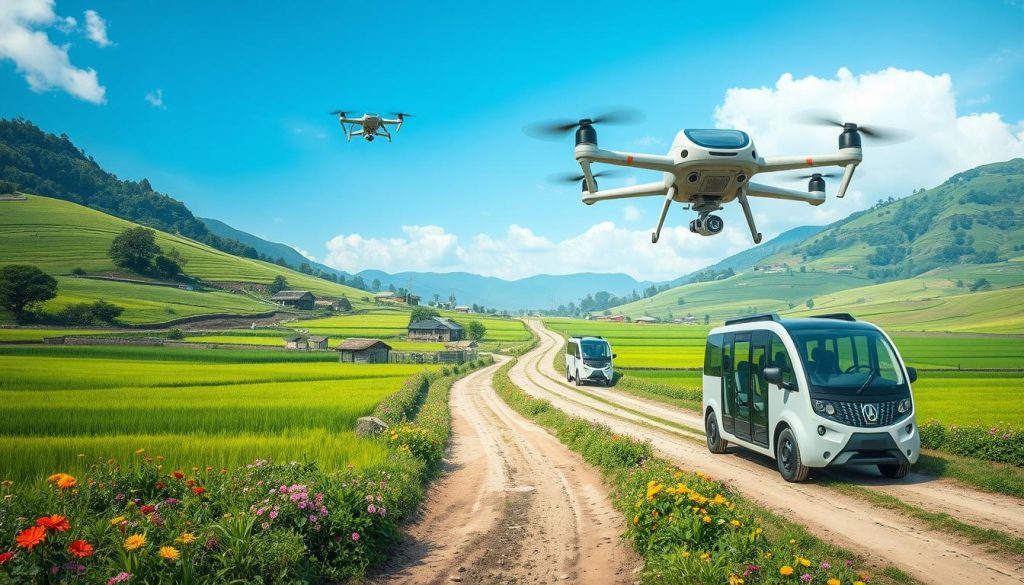
Efficient transportation and logistics are key for businesses in rural areas. They face challenges like poor infrastructure and limited access to markets. New solutions are needed to move goods better.
Modern rural delivery services are becoming vital for local economies. They improve connectivity and boost trade.
Rural Delivery Services
Rural delivery services are essential for better logistics in rural areas. They ensure products get to consumers on time and reliably. These services focus on:
- Using local transport networks, often involving community members to connect.
- Using technology to make ordering and tracking easier, enhancing customer experience.
- Adjusting delivery methods to fit the terrain and infrastructure challenges in rural areas.
By creating custom transportation solutions, rural delivery services tackle existing challenges. They also open up new market chances. This helps local businesses grow and gives consumers access to more products. It promotes economic growth and sustainability in the area.
Financial Services and Microloans

Getting access to financial services is key for starting businesses in rural areas. Banks and other lenders offer microloans to help local entrepreneurs. These loans give them the money they need to start or grow their businesses.
Microfinance institutions provide financial services that meet rural needs. They offer:
- Small loans for entrepreneurs starting new ventures.
- Group lending schemes to help local business owners work together.
- Financial literacy programs to teach loan management.
The impact of microloans is huge. Many stories show how these loans help people in rural areas. They can buy equipment for farming, make crafts, or start new services that help their communities.
These efforts not only grow the local economy but also help people get out of poverty.
Also, working together on financial services builds stronger community ties. This trust helps rural entrepreneurs face challenges better. Financial services, especially microloans, are vital for lasting economic growth in rural areas.
Digital Marketing for Local Businesses
Digital marketing is now key for local businesses in rural areas. It helps them reach more people, beyond their physical location. Understanding digital platforms is crucial for targeted marketing, boosting sales and expanding their customer base.
Social media is vital for local brands to get noticed. Using Facebook and Instagram, businesses can connect with their community and build loyalty. Also, search engine optimisation helps them show up in online searches, making them easier to find.
Studies show that using local SEO is essential for local businesses. It improves their online visibility for people looking for what they offer. This way, rural businesses can grow and succeed in today’s digital world.
















